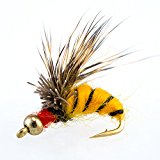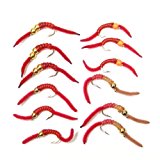Fly Fishing Lures

Guide to fishing flies, types, best uses and techniques.
What are fly fishing flies?
Flies are created by tying hair, fur, feathers and other materials onto a hook using thread. They are light and designed to either float or sink, with floating flies being the most popular in the world, with the exception of Britain.
Unlike other casting methods, fly fishing is more about casting the line, or manipulation of the line.
Fly fishing technique
The fly fishing rod movement is commonly referred to as “10 to 2”. This means that the rod’s movement on the forward cast is arrested at the 10 o’clock position and the backcast at 2 o’clock.
Well worth checking out the video at the bottom of this article for some fly casting tips. Before we go on to describing the different flies, let’s look at the two main types:
- imitative flies are pretty much dead ringers for the food item or fish prey
- attractive flies trigger instinctive strikes through imitating fly movement
Types of fishing flies
Dry Fly
 No surprises here, dry flies float and are designed to float in their construction. They’re created to resemble insects, their larvae or insects that fall to the water from shrubbery or the sky.
No surprises here, dry flies float and are designed to float in their construction. They’re created to resemble insects, their larvae or insects that fall to the water from shrubbery or the sky.
Construction takes years of experience. Not only do they have to look life-like, but there are several steps that must be done correctly. This is to ensure the fly will sit right, stay dry and not sink.
Dry flies are usually tied with hackles to make them float high and may require a foam core or floating fly line. They’re then treated with a special water-repelling dope, which prevents water logging.
To use: Cast dry flies upstream and let them be carried downstream with the current with the odd yank on the line to create a twitch.
 Wet Flies
Wet Flies
Unlike the dry fly, wet flies are design to sink and are not as popular in North America as dry flies, streamers and nymphs. However they’re very popular in Britain and Scotland.
Wet flies are very successful against large trout and salmon.
Streamers
Streamers are flies that have been designed to resemble baitfish and not insects. They’re fished on a fly line, trailing behind a jig, trailing behind an underwater lure or on a dropper.
Nymphs
Nymphs resemble the larval stage of insects. Like wet flies they’re designed to sink. True nymphs are tied, but they’re also a lot of plastic nymphs on the market.
A popular fly fishing technique is nymphing. This is fly fishing on stream bottoms. This technique can be used in most any season but winter, or whenever the ice covers the water.
Weighted Flies
Fly weight is usually inconsequential. Nymphs and wet flies are designed to sink so they may have some added weight. However, when weights are added to flies or the lure, they are not considered flies anymore but more of a light casting tackle.
Bugs
There are plain bugs and there are popping bugs. Popping bugs are also known as fly-rod poppers, bass bugs and bass poppers.
Popping bugs are designed to look like insects and are made with cork or some other spongy material. Non-popping bugs imitate insects, frogs, mice and the list go on a long way.
Keel Flies
Tied as streamers, keel flies have a bent shank from just below the top part of the shank to about a 1/5 down the line of the shank towards the hook. Keel flies are considered weedless. As a result are a lot more fun to work with than streamers.
Plastic Flies
Plastic flies are not flies. Most anglers consider these plastic flies to be ultralight lures. They come in a variety of replicas including ants, crickets, grasshoppers, worms, crayfish, minnows and so on.
The return knot works well with standard baits for small fish as well as with flies. Click here for a step by step guide showing how to tie the return.





